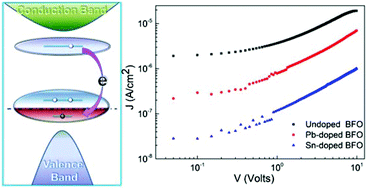The role of Bi vacancies in the electrical conduction of BiFeO3: a first-principles approach
Abstract
We employ first-principles methods to study the mechanism controlling the electrical conduction in BiFeO3 (BFO). We find that under oxygen-rich conditions, Bi vacancies (VBi) have lower defect formation energy than O vacancies (VO) (−0.43 eV vs. 3.35 eV), suggesting that VBi are the acceptor defects and control the conductivity of BFO, making it a p-type semiconductor. In order to obtain further insight into the conduction mechanism, we calculate the effect of donor (Sn4+) and acceptor (Pb2+) impurities in BFO. Results indicate that Sn impurities prefer to substitute Fe sites to form shallow donor defects, which compensate the acceptor levels derived from VBi. Meanwhile, Pb atoms favour the substitution of Bi sites to form acceptor defects, reducing the overall concentration of holes (h+). Theoretical findings were later surveyed by current–voltage characteristics of Sn- or Pb-doped BFO nanofibers. This study is of general interest in carrier transport in charge compensation semiconductors, and of particular relevance within the context of defect-mediated conductivity in BFO.


 Please wait while we load your content...
Please wait while we load your content...